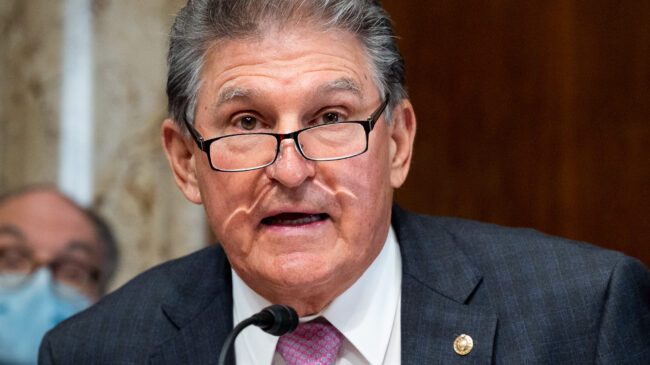Tens of millions of American families began receiving checks worth up to $3,600 annually per child from the federal government in July due to the recently-passed child tax credit. As Congress debates its proposed reconciliation bill, recent legislative wrangling has cast doubt on whether the child tax credit will become a long-term fixture in the U.S. tax code and anti-poverty efforts—with some wanting to make the changes permanent, others proposing to extend them only one year, and others opposing them entirely.
In the current House and Senate showdown, Sen. Joe Manchin (D-WV) has emerged as the crucial centrist “swing vote.” Sen. Manchin recently proposed sweeping changes to the still-new child tax credit, including reducing the ceiling for eligible families dramatically—to only those earning under $60,000 per year—and adding a work requirement for recipients.
Last month on CNN, Sen. Manchin said the tax credit had “no work requirements whatsoever” and asked, “Don’t you think, if we’re going to help the children, that the people should make some effort?” This sentiment surrounding work requirements has proven politically potent for decades and, at least at first pass, seems to be built on economic common sense. These concerns also resonate with many people right now because during the COVID-19 pandemic unemployment insurance benefits became more generous and many are observing a shortage of workers, especially in service industries.
However, recent history shows that work requirements for cash assistance to poor Americans often work much better as political sloganeering than as real programs. For example, the Temporary Assistance for Needy Families (TANF) program, instituted in the mid-1990s, added work requirements to the cash assistance program formerly known as American Families with Dependent Children (AFDC). Despite persistent conventional wisdom that benefits should be tied to a willingness to work, the benefits of this major shift were modest and uneven. The results were so weak as to indicate if the ultimate policy goal is helping families emerge from poverty in robust and self-sustaining ways, unconditional benefits may be a better solution.
The same would likely be true of Sen. Manchin’s proposed child tax credit reforms, which should be rejected even in the current climate of labor shortages in some sectors. The “get a job” mentality Manchin imposes, when put into practice, would only result in cosmetic improvements to employment rates and the size of the welfare state. In addition to fewer monthly checks, Manchin’s proposed reforms are a step back in our thinking and framing of debates regarding poverty and work.
The Same Mistakes
In our complicated welfare system, consisting of dozens of programs combining various cash and in-kind benefits with an array of differing eligibility and behavioral requirements, calculating the cash impact of the child tax credit on the “average” recipient family is difficult. But what emerged following this spring’s earlier round of legislative wrangling was a tax credit that differed from other assistance programs currently on the books in three important ways:
- Eligibility for families with higher incomes than existed in other assistance programs;
- A lack of requirement that any member of the family be working or looking for work;
- A simpler and less bureaucratic system.
Sen. Manchin’s proposed changes take aim at the first two characteristics of the child tax credit. However, his lack of specifics obscure the fact that even a well-designed approach to rolling back those first two characteristics impacts the third. Based on past welfare reforms, Manchin’s requirements would mean a system with a bigger bureaucracy that is far more expensive to run and rife with benefit cliffs and loopholes with unintended consequences.
Eligibility for a means-tested program is always more complicated than earnings above or below a single number. How many earners does the family have? What income gets counted? What about other benefit programs? Beyond the income ceilings, do benefits phase out gradually or simply fall off a “benefit cliff?” Beyond the $60,000 figure, Manchin has not answered these questions.
The current child tax credit begins phasing out benefits at higher incomes: $112,500 for single parents and $150,000 for joint filers. It then phases out very gradually, with partial benefits available to single parents and couples earning as much as $200,000 and $400,000, respectively.
Many frame this eligibility over wider income brackets as “paying people not to work.” That isn’t quite correct. Beneficiaries are being paid, which impacts work and other life decisions, but their work decisions on the margin are left to them as free decision-makers with richer knowledge about themselves and their circumstances than policymakers have. Steep benefit cliffs at lower income thresholds are where policy actually impacts those marginal decisions more sharply and creates top-down disincentives to work.
The work requirement called for by Sen. Manchin adds additional bureaucratic strain. The Internal Revenue Service (IRS) can issue checks directly, but a major bureaucratic undertaking is needed to determine who is and isn’t working, is or isn’t looking for a job, and does or doesn’t have some exemption or extenuating circumstance.
Manchin’s direct, yet also vague, call for a “work requirement” for the child tax credit is therefore problematic over his other proposed changes. The experience of the TANF program is instructive, as it was born when such a work requirement was added to the federally-funded but state-administered AFDC cash assistance program. In the years following the change, welfare rolls were cut by several million recipients but the bureaucracy and overall spending only grew.
Different Results
The shortage of service workers as the nation tries to emerge from the COVID-19 pandemic might appear to some supporters of work requirements as further evidence of their importance. In the wake of extended unemployment benefits and the introduction of the child tax credit, it can look to many like we are indeed paying people not to work. But this story becomes more complicated when viewed as millions of heterogeneous individuals and jobs in a complex economy.
Based on an interview with Indiana University economist Kyle Anderson, Indianapolis Star reporter Binghui Huang writes that the “reasons range from fear of COVID-19, child care needs at home, mismatch of skills between the worker and the job, changing career interests and early retirement.”
We should instead approach the labor shortages currently observed as a question similar to the general supply-chain dislocations also in the news. Indeed, unfilled jobs and cargo ships stuck outside ports are two aspects of the same problem. Writing for Reason Foundation, Marc Scribner illustrates step-by-step a scenario of “cascading impacts” from COVID-19 that lead to such problems in product markets. Scribner is rightly concerned about big policy gestures making the problem worse:
“With the public and businesses feeling the impacts of supply chain problems and news stories already scaring parents that their Christmas toys may not arrive in time for the holidays, politicians are likely going to continue wanting to show they are doing something about the problem by holding summits with business and labor leaders, appointing “czars,” and engaging in other photo opportunities to present the illusion that they can solve these problems. But the reality is supply chain problems are largely out of policymakers’ control and almost certain to continue through 2022. Markets and businesses will adjust but not on a dime.”
Counseling patience in today’s political and media environment may be an uphill climb, but Scribner is exactly right about both the product and labor markets. COVID-19 hit the complex system of our modern economy with countless shocks. In both product and labor markets, the bottom-up process of finding a robust new normal has no shortcuts.
All the more reason for assistance to workers that is dependable and does as little as possible to distort specific decisions on the ground. Both the left and right are attracted to policies designed to make people do what they think people should do, but avoiding this trap is good advice both in our peculiar current set of affairs and in general. We have seen enough examples of the futility of more top-down micro-managed approaches to expect different results.

